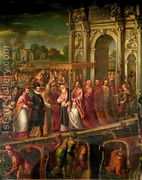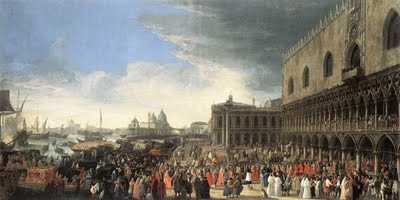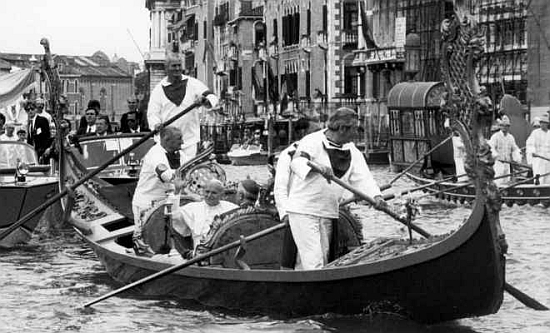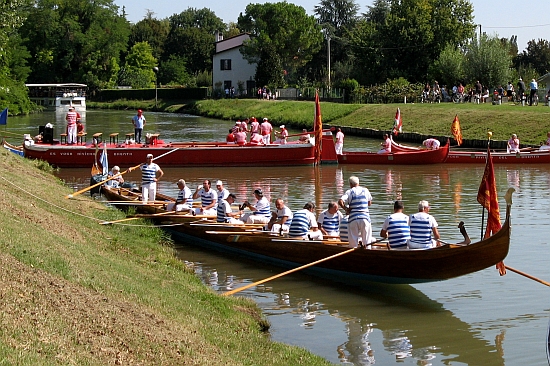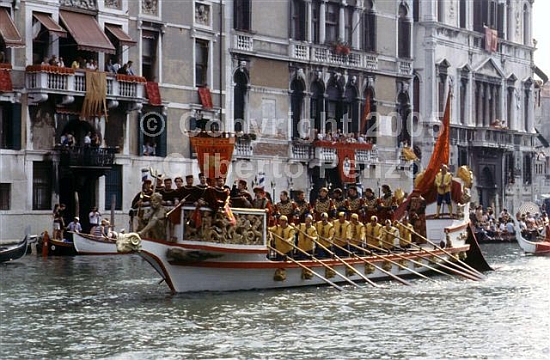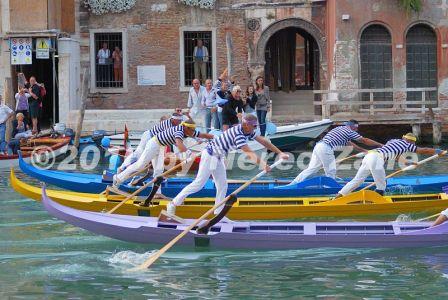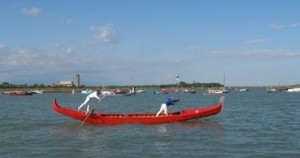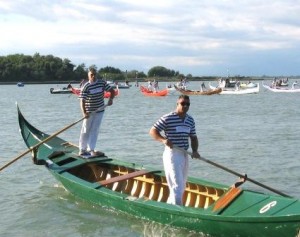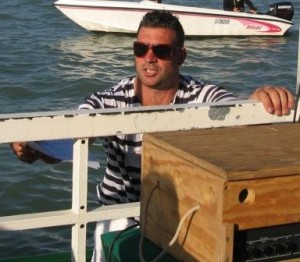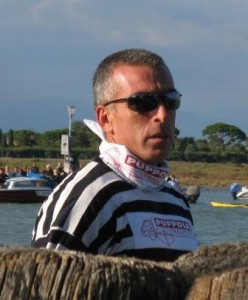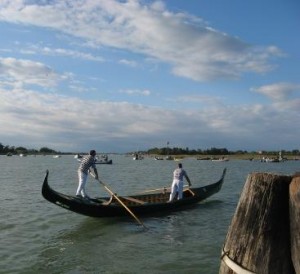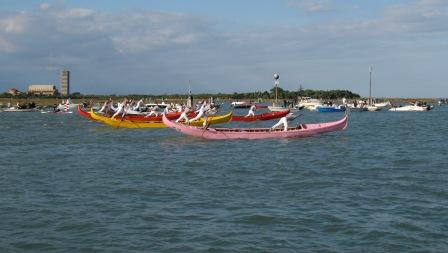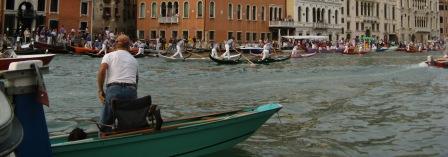The results of the two elections held among the gondoliers have come in and now the pope can sleep easier knowing who exactly is going to be rowing him from one shore to the other next Sunday. (One of them won’t be Charon. I presume.)
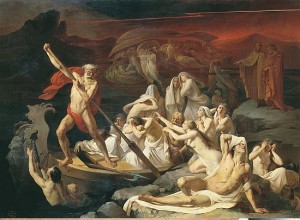
And the winners are: Franco and Bruno Dei Rossi, nicknamed “Strigheta” (not much of a surprise there, they were at the head of the pack several days ago), and one each of the two famous battling pairs of racers: From the “Vignottini,” Igor Vignotto; from the other, Giampaolo D’Este.
Comments in the Gazzettino on this outcome were as sardonic as they were swift:
“This is splendid news. In the end, love always triumphs.”
“Since when have gondoliers all become basibanchi (these are those obsessively pious people who are always in church)? Is this the miracle we’ve been waiting for from Giovanni Paolo II?” (who was beatified yesterday, first step on the road to official sainthood).
“Given the well-known diplomatic refinement among these four, it makes one wonder … if they can manage not to swear at each other for ten minutes. It wouldn’t be so bad even if it were to happen. Venice couldn’t present itself worse than what it is, even if it wanted to.”
So everyone has finally calmed down? I know one person who hasn’t: Lino. He is all of the following: Astonished, infuriated, and offended, genuine, incandescent emotions far removed from the Lilliputian self-serving quibbling that has distinguished this whole affair.
Why is Lino so angry? Because of all the people mooted for the Papal Row, he regards Igor Vignotto as the last — actually, far behind the last — gondolier who deserves this honor.
Yes, we remember in the end that rowing the pope is, in fact, an honor, and not just another gig. I realize that “honor” is a word that rarely — well, never — seems to find a seat on the bus of normal conversation regarding gondoliers, but a papal visit is a noteworthy exception and the men who row him ought to have consciences which have been washed at least on the “delicate” cycle.
Igor and Giampaolo have two things in common. One is that they both row in the bow of the gondolino, which means that they, at least technically, can’t be considered guilty of all the skulduggery which has led to the current bitterness because they aren’t the ones responsible for steering the boat. All they’re doing up there in the front is rowing their brains out.
Their other link, unfortunately, is that they both were banished from racing for the entire 2008 season because of their respective crimes in 2007.
In the case of Giampaolo, he was found guilty of having threatened a race judge with serious bodily harm, his way of asserting his innocence regarding an infraction during a race for which the judge had punished him. The infraction is one thing, but stating in the hearing of many people that he would be prepared to settle the score by attacking the judge physically is, as they say here, “another pair of sleeves.” Also, there’s a rule against it.
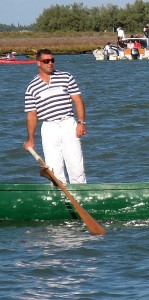
I note that he only said he wanted to do it, he didn’t actually hurt anybody. This is a good thing, because while privacy laws make it difficult to discover his exact height and weight (I could probably do it eventually, but time is short), I can say that he appears to correspond to the stature of a two-year-old grizzly. One of his nicknames is “The Giant.” But rules are rules, even for midgets, and we can’t have racers going around volunteering to bash the judges.
But Igor’s case was worse, because what he did not only offended the rules and the judges, but all the other racers — those present as well as the hundreds stretching back into history — and the entire world of racing and, in a sense, the city of Venice itself.
It happened at the end of the culminating race of the Regata Storica three years ago (September 2007), in what then was a notorious altercation but which now seems to have been totally forgotten (which also adds to Lino’s indignation),
It’s true that the race had been unusually fierce, even by the standards of the searing rivalry pitting him and his cousin against the D’Este-Tezzat pair, and it’s true that the finish was so close that the judges had to check the video to determine the winner. But when Igor heard that they had given him second place, he kind of lost his mind.

Not only did he engage in a volcanic exchange with the mayor, Igor grabbed the prize pennants and threw them into the Grand Canal.
Not just the two pennants destined for him and his cousin, but all eight pennants waiting to be awarded to the rowers of the first four boats to finish.
Of the many things which, in the view of various people, would have been much better thrown into the water (the “Boy with the Frog” being one of them), pennants have never, and should never, be treated in this manner. Set aside the fact that not all of them got fished out in time; or the fact that those that were fished out were essentially D.O.A., thanks to the salt water. It’s not even a question of whether the city made replacements. It’s not even a question. He shouldn’t have done it, and however good it may have made him feel at the moment, that’s how bad it made everybody else feel.
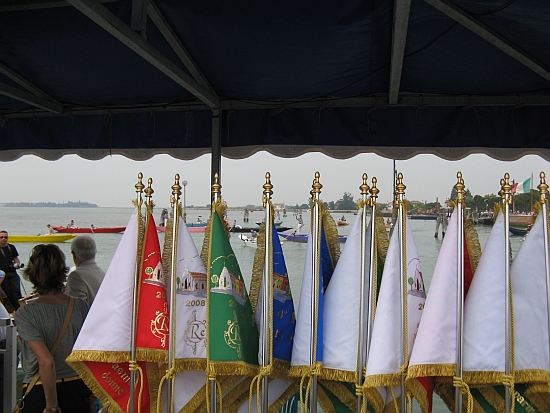
So when Lino heard that Igor was one of the Papal Rowers, it was Too Much, even in a city where things that are Too Much happen every day.
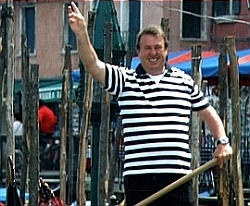
First a rower allows himself to essentially spit in the collective eye of the city, the race, the other racers, and history, and now he gets a reward? Of all the people who could have been chosen, they chose a person who had committed an outrage that had never been committed by anyone, not even “Mad Dog” Sullivan. And, strange to say, so far Lino is the only person who has expressed any opinion on this.
There’s a sprightly ditty in the second act of “The Gondoliers,” by Gilbert and Sullivan. It’s called “Here we are at the risk of our lives.”
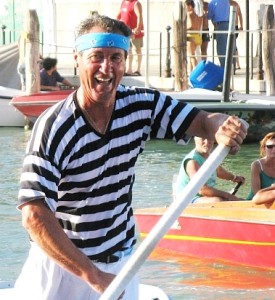
I think it should be played in the background all day next Sunday.

